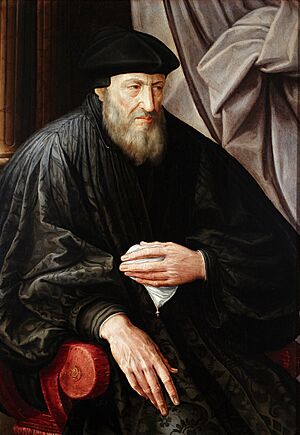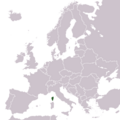Battle of Girolata facts for kids
Quick facts for kids Battle of Girolata |
|||||||
|---|---|---|---|---|---|---|---|
| Part of the Ottoman–Habsburg wars | |||||||
 Corsica shown in green |
|||||||
|
|||||||
| Belligerents | |||||||
| Commanders and leaders | |||||||
| Strength | |||||||
| 21 galleys | 11 galleys | ||||||
| Casualties and losses | |||||||
| minor | 11 galleys captured, 1,200 prisoners, 1,200 galley slaves freed |
||||||
The Battle of Girolata was an important sea battle. It happened on June 15, 1540, near the island of Corsica. This fight was part of a bigger war between Charles V of Spain and Suleiman the Magnificent, a powerful Ottoman leader.
A Spanish fleet of 21 ships, called galleys, was led by Gianettino Doria from Genoa and Berenguer de Requesens from Spain. They surprised an Ottoman fleet of 11 galleys. These Ottoman ships were anchored in the Gulf of Girolata. Their leader was Admiral Dragut.
Dragut had been sent by Hayreddin Barbarossa, the head of the Ottoman Navy. His job was to raid the coast of Italy. The Ottoman crews were on land, sharing their stolen goods. The Spanish-Genoese fleet attacked them easily. They captured all 11 Ottoman galleys and took 1,200 prisoners. Dragut was one of them. He was taken to Genoa and made to row in Andrea Doria's galleys.
Why the Battle Happened
In 1538, the Ottoman fleet, led by Hayreddin Barbarossa, won a big victory. They defeated a fleet from Spain and Italy at the Battle of Preveza. They also captured a place called Castelnuovo.
In 1540, the Ottoman navy was not very strong. This was because their leader, Suleiman, was planning a land war in Hungary. So, Barbarossa sent his best scout, Dragut, to the western Mediterranean Sea. Dragut's mission was to raid the Italian coast. He also had to bother Spanish ships. This type of raiding was called privateering.
Dragut started his journey by capturing five ships from Venice. This happened near the island of Paxos. Venice could not fight back. They had just signed a peace treaty with the Sultan.
To stop the Ottoman threat, Charles V's admiral, Andrea Doria, gathered a large fleet. He had about 80 galleys in the port of Messina. His goal was to clear the Ottoman raiders from the Western Mediterranean.
Andrea Doria divided his ships into five groups. Each group was sent to patrol a different area. Andrea Doria himself sailed from Messina with 55 galleys. He hoped to surprise Dragut near Djerba. But Dragut had moved faster.
Doria sent his relative, Erasmo Doria, to guard the Balearic Islands. He had 10 galleys. His nephew, Gianettino Doria, and Berenguer de Requesens were sent to patrol near Corsica and Sardinia. They had 21 galleys. Other commanders were sent to protect Naples and Sicily.
Gianettino Doria and Requesens' group found Dragut's ships. People first saw the Ottoman ships near Bonifacio. Later, when Dragut attacked the island of Capraia, the sound of cannons was heard. Fishermen who had escaped the Ottomans warned Doria and Requesens. They said Dragut had sailed to Cape Corso. Then, they reported that his ships were anchored in the Gulf of Girolata.
The Battle Begins
The Ottoman ships had stopped in the Gulf of Girolata. They were there to share the goods they had stolen. Dragut chose this spot because it was empty. It was also far from normal shipping routes. Because of this, he did not leave any ships to guard the entrance to the gulf.
When Gianettino Doria's fleet arrived nearby, he sent his relative, Giorgio Doria, into the gulf. Giorgio had 6 galleys and a small rowing boat. His job was to see the anchored Ottoman ships.
Stories about the battle are a bit different. Some say the Ottoman sailors and soldiers were on shore. They were sleeping or eating when the Spanish ships surprised them. About 600 Ottomans ran into the mountains before the fight even started. Dragut barely had time to get on his ship and fire one shot. Then, the Genoese and Spanish ships boarded his main ship and the others. Many of his men jumped into the water to escape to land.
Another story gives more details. It says Dragut had time to get his crews onto their ships. He saw the 7 ships Doria sent ahead. He left 2 galleys to guard the stolen goods. Then, he sailed with his remaining 9 galleys to fight Giorgio Doria's group.
Dragut thought he would have more ships. But he sailed right into a trap set by Doria and Requesens. Their other 15 galleys appeared from the west. They had the wind on their side. Dragut tried to turn his ships around to escape. But the Spanish galleys came up behind him. He decided to try to break through them.
Then, a single shot from Gianettino's ship hit Dragut's main ship. It caused a lot of damage, and the ship almost sank. Dragut lost hope of escaping. Most of the Ottoman sailors and soldiers jumped overboard. They swam to the beach to save themselves by running inland.
What Happened After
The Spanish fleet captured all 11 Ottoman galleys. Two of these ships, the Moceniga and Bibiena, had been taken by the Ottomans at the Battle of Preveza. The Spanish also took 1,200 Ottoman prisoners. They freed 1,200 Christian galley slaves.
Dragut was among the Ottoman prisoners. He was very angry about being captured by a young man like Gianettino Doria. He insulted his captor. Gianettino Doria then beat him in return. Dragut was taken to Genoa. He was made to row as a galley slave.
A French historian from the 1500s, Pierre de Bourdeille, wrote about this. He said that Jean Parisot de Valette, who would later become a famous leader of the Knights Hospitaller, saw Dragut rowing. Valette said to him, "Mr. Dragut, this is the custom of war!" Dragut replied, "And a change of fortune."
In early 1541, Barbarossa paid 3,500 ducats (a type of gold coin) to free Dragut. Later, some thought Doria made a mistake by freeing Dragut. He hoped to gain favor if one of his own family members was captured by the Ottomans.
After Dragut's defeat, Andrea Doria sailed from Messina that summer. He had 51 galleys and more than 30 smaller ships. On board were 14 groups of Spanish soldiers. They were led by García de Toledo.
They attacked Ottoman bases in Tunis. They captured strongholds like Monastir, Sousse, Hammamet, and Kelibia. They gave these places back to the local ruler, Muhammad V.
Barbarossa's raiding campaign was stopped again. On October 1, Spanish ships defeated the Turkish raiders again. This happened at the Battle of Alborán, east of the Strait of Gibraltar.
Images for kids
See also
 In Spanish: Batalla de Girolata para niños
In Spanish: Batalla de Girolata para niños







